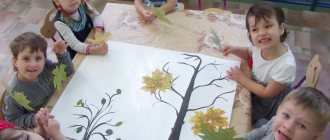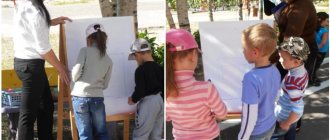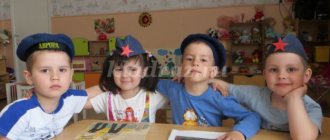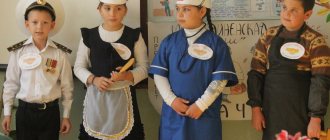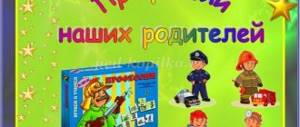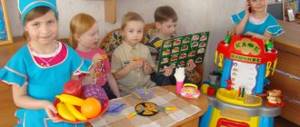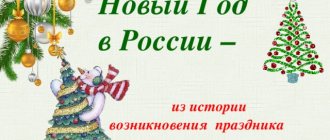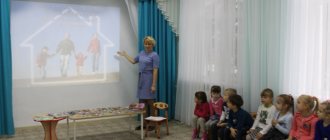Project on the theme “New Year at the Gates”
Municipal budgetary preschool educational institution "Kindergarten No. 1 of a general developmental type with priority implementation of the cognitive and speech direction of development of pupils"
Project on the topic
"New Year at the Gate"
Educator: Chekanova N.G.
I qualification category
2019
Content
Explanatory note————————————————————————3
Project goal————————————————————————————3
Project objectives———————————————————————————-3
Expected result——————————————————————4
Project type ————————————————————————————4
Project type ————————————————————————————4
Composition of project participants ——————————————————————4
Problem situation ————————————————————————4
Project products ——————————————————————————4
Facilities and equipment ———————————————————————4
Stages of project implementation——————————————————————-5
Long-term plan for the project ———————————————————-6-8
References used———————————————————————-9
Explanatory note.
The diversity, richness, and spiritual wisdom of the lives of our ancestors represent excellent opportunities for the education of morality. Therefore, the main idea of the project is based on the formation of love and affection for one’s culture, one’s people through the rational use of national holidays based on musical folklore, oral folk art, traditions and customs.
Everyone knows that the most favorite holiday for children is New Year. The pre-New Year bustle, letters to Santa Claus, decorating the Christmas tree and long-awaited gifts under it - all this cannot be compared even with a birthday. When preparing for the New Year celebration, children often had questions: why do they decorate the Christmas tree? Is Santa Claus real? Where does he live? Will Santa Claus bring gifts? Search and research activities carried out during the implementation of the “New Year at the Gates” project will help to understand these issues.
The goal of my project is not only to introduce children to the traditions of celebrating the New Year, but also to give children a holiday and gifts, real New Year's Magic!
An important place in this project is occupied by the study and preservation of the traditions of celebrating the New Year, which helps satisfy children’s cognitive interest in this holiday. The project is aimed at preschool children and allows you to create a joyful emotional atmosphere on the eve of the New Year holiday
Project objectives:
Educational:
- develop speech activity;
- develop fantasy and imagination;
- develop observation, aesthetic perception, emotional responsiveness
- reveal the capabilities and creativity of children through a variety of activities
Educational:
- strengthen child-parent relationships. Encourage parents to engage in joint creative activities with their children
- arouse the desire in children and parents to participate in preparations for the holiday (decorating the group, making crafts). — involve parents as active participants in the life of the group in preparation for the New Year holiday Educational:
- analyze the concept of holiday - New Year, highlight its characteristic features and traditions. Create a New Year's mood.
Expected result:
• enriching children's knowledge about the New Year holiday;
• children’s awareness of the kind, caring attitude of people towards each other and the mood during the holiday - New Year;
• active participation of children and parents in preparation for the New Year.
• increasing the level of awareness of parents about the activities of preschool educational institutions.
Type of project : educational and creative.
Project type : short-term (from 12/16/19 to 12/31/19)
Project participants : children of secondary group No. 8, parents, teachers.
Problem situation: Children and parents are not familiar with the history of the New Year tree, parents do not understand the importance of sharing New Year’s traditions with their children.
Project products :
• Exhibition “Father Frost's Workshop”.
• New Year's celebration.
Integration of educational areas: cognitive development, speech development, social and communicative development, artistic and aesthetic development, physical development.
Integration of children's activities: play, cognitive-research, motor, productive, communicative, reading (perception of fiction), music and art.
Subject-spatial development environment: kindergarten territory; in the group: visual aids.
Facilities and equipment:
Technical: TV, video recording of the cartoons “Santa Claus and Summer”, “Snowman-Postman”
Methodological: visual aids, illustrations about the New Year holiday, “New Year” coloring pages, a selection of works of art.
Organizational: tables, oilcloths, paper, wax crayons, watercolors, gouache, brushes.
Project in the Preparatory Group “What is the New Year?”
Project in the Preparatory Group “What is New Year?”
Educator: Topalyan. E.P.
Project type
: educational and playful.
Project type
: short-term from 9.12 to 27.12.19
Project participants
: children
of the preparatory group
, parents.
Relevance: New Year is the most favorite holiday in our country. Both adults and children love him. New Year is a holiday with fluffy white snow, the smell of fir branches, the sparkle of multi-colored toys and tinsel, gifts, as well as with an elegant Santa Claus and the beautiful Snow Maiden; a cheerful holiday cannot be compared with a birthday. But as a result of a survey conducted by the teacher in the group
, it turned out that not only children, but also adults, their parents, know little about the history of the holiday and its traditions, the traditions of celebrating the New Year in other countries.
Therefore, we decided to find out as much as possible about this, as well as decorate the group for the New Year
. It's no secret that the hardest thing for kids is to wait, and even more so to wait for a holiday. Therefore, one of my tasks was to make this wait fun, enjoyable and useful for the children.
Objective of the project
:To form the concept of “holiday”, its characteristic features, meaning in people’s lives using the example of the New Year.
Project objectives
:
Analyze the concept of the New Year holiday, highlight its characteristic features, attributes, attitude and mood of people, rules of behavior, traditions.
Create a desire to participate in preparations for the holiday (decorating the group, manuals, crafts, photo newspapers about the New Year).
Involve parents in preparing for the New Year holiday.
Introduce children to the rules for decorating a Christmas tree, expand children’s knowledge about fire-hazardous items;
To promote the development of the ability to make appliqué from colored paper, to work correctly with scissors and glue, paper, plasticine; improving cutting techniques, developing accuracy and composure, and creative abilities;
Contribute to the development of communication skills, independence, initiative, creative imagination while inventing various stories, fairy tales, poems on New Year's themes;
Project methods
:
Reading literary works about the New Year holiday.
Creative activities of children together with parents
Implementation stages:
Stage 1 preparatory
Selection and development of necessary materials (Thematic classes, conversations, selection of fiction, illustrations about the New Year holiday.
Stage 2 main
Social and communicative development
Conversations
: “Where is the New Year from?”, “HOW DO WE CELEBRATE the New Year in the senior group?”, “New Year traditions,” “What do we like in winter?”
Project for children of the preparatory group on the theme: New Year
Project for the preparatory group “New Year's Story”
Everyone knows that the most favorite holiday for children is the New Year. New Year's bustle, letters to Santa Claus, home decoration, long-awaited gifts under the tree, a cheerful holiday with the family, a warm atmosphere...
Historical reference.
New Year is celebrated in all countries of the world. The tradition of celebrating the New Year in general, and January 1 in particular, has a very long history, and it is associated with the name of the first Roman emperor Gaius Julius Caesar. The era, or starting point of the Roman calendar, was traditionally accepted as the year of the founding of Rome, and March 1 was considered the beginning of the year. Instead, January 1 was then adopted as the calendar era, the time of the assumption of office by the first officials of the Roman state - two consuls, the republican kings of Rome. All citizens of Rome were accustomed to receiving gifts on January 1 from the consuls taking office, who spared no expense for this. Caesar himself almost went bankrupt, paying for unprecedented festivities. In Rus', the celebration of the New Year in its modern form is closely connected with the name of Peter 1. In pagan times, the New Year in Rus' was celebrated on March 1. On this day, the Slavs tried to appease their gods by decorating the cherry tree with candles and various offerings. Since 988, after the adoption of Christianity, the New Year began to be celebrated on Simeon's day - September 1. And only since 1700 our ancestors began to celebrate it in January. Peter I, who in his youth visited his German friends for Christmas, was pleasantly surprised to see a strange tree. It looks like a spruce tree, but instead of cones there are apples and candies on it. The future tsar was amused by this, and he immediately introduced the custom in Russia at Christmas of decorating coniferous trees with various kinds of toys and dishes, as well as lighting candles and fireworks. Having become emperor, Peter I issued a decree to celebrate the New Year, as in enlightened Europe: “Count the New Year not from the first of September, but from the first of January 1700. And as a sign of that good beginning and the new century, cheer each other up and congratulate each other on the New Year. Along noble streets and thoroughfares, at the gates, make decorations from trees and branches of pine, spruce and juniper.” The Christmas tree in Germany was considered a symbol of eternal youth and strength. By the way, back then the trees were hung from the ceiling with the top down, only later they began to be fixed on the floor. Some sources report that upside down trees were the first Christmas decoration in Central and Eastern Europe back in the 12th century. The trees, tradition says, were hung upside down from the rafters. The sacred tree, growing with its roots upward and thus connecting heaven and earth, is mentioned in the ancient Indian Upanishads. Gradually, the tradition of bringing a Christmas tree into the house spread throughout Europe. At first, Christmas trees appeared only in the homes of rich people. The custom of installing Christmas trees everywhere in homes appeared about 150 years ago. It was then that evergreen beauties began to be installed every year in the royal and royal palaces of France, Germany, England, Norway, Denmark and Russia. The Christmas tree became the property of the common people only in the second half of the 19th century. Although the old German rite was pagan and glorified forest spirits, the image of the Christmas tree fit very well into the Christian religion. Christmas tree decorations, sweets and fruits symbolized the gifts brought to the little Christ. And the candles resembled the lighting of the monastery in which the holy family stayed. In addition, a decoration was always hung on the top of the tree, which symbolized the Star of Bethlehem, which rose with the birth of Jesus and showed the way to the Magi. As a result, the humble tree became a symbol of Christmas. The New Year tree has several legends about its appearance. So, according to Christian legend, the spruce came to the light of the star of Bethlehem, but was embarrassed to approach the baby, because she had no gifts. And then the plants shared their gifts with the spruce. Since then, every year the spruce tree is decorated for the birthday of Christ. According to another legend, in winter the spirits of the forest move into spruce trees, so they used to be placated with various decorations so that the year would be good. Everyone knows that the most favorite holiday for children is New Year. The pre-New Year bustle, letters to Santa Claus, home decoration, long-awaited gifts under the tree, a cheerful holiday with the family, an atmosphere of warmth - all this cannot be compared even with a birthday. But as a result of a survey conducted by teachers and children in the preparatory group, and examination of the pictures, it turned out that children have difficulty distinguishing our Father Frost from Santa Claus, and their knowledge about Father Frost is superficial. Therefore, we decided to find out as much as possible about these characters, and also determine what gifts Santa Claus gave to parents when they were children and compare whether anything has changed over so many years. In the preparation and implementation of the project, New Year's cards, images of Father Frost, the Snow Maiden and Santa Claus, carnival costumes of Father Frost, the Snow Maiden and animals, art supplies, audio and video materials on the topic were used. In December, the teacher talked with the children about the signs of winter and about winter holidays. As a result, it turned out that most children are looking forward to the New Year. Everyone wanted to decorate the Christmas tree, perform at the matinee, have fireworks with their parents and, of course, wait for Santa Claus. But no one knew what the New Year was and why Santa Claus came. When children were offered pictures of Father Frost and Santa Claus, many could not give clear answers whether they were the same character or completely different. Also, no one answered where Santa Claus lives. Therefore, research work was carried out. Children asked their parents at home and shared information about the New Year, compared and rated the cards they brought. Illustrative, literary and video materials on this topic were received with interest. As a result, the children learned to find the differences between Santa Claus and Father Frost, and learned about New Year traditions in different countries of the world. The children expressed their opinion about the legends about the appearance of the New Year's tree. After looking at the images of Father Frost’s estate and finding out his address, we decided to write letters to Veliky Ustyug at home with our parents. Thus, as a result of the work carried out jointly with adults, children received extensive knowledge about the New Year and the traditions of celebrating this holiday in different countries. In addition, the guys experienced pleasure from the collective preparation for the holiday, from the work done, from the very process of musical and creative communication on the theme of their favorite holiday.
Project "New Year's Story".
Relevance and significance: The project was developed due to the particular relevance of the problem of patriotic education of the younger generation. Patriotism in modern conditions is, first of all, devotion to one’s Fatherland, and the preservation of the cultural identity of each nation. The diversity, wealth, and spiritual wisdom of the lives of our ancestors provide excellent opportunities for the education of morality. Therefore, the main idea of the project is based on the idea of folk pedagogy for the formation of attachment to one’s culture, the rational use of national holidays, based on folk traditions and customs. An important place in this project is occupied by the study and preservation of New Year celebration traditions. In the process of integrated thematic classes, children’s knowledge and ideas about folk traditions, customs of celebrating the New Year, its attributes, characters, the best musical, literary and film works on the topic expand. Type of project: a) According to the composition of participants - group (children, teachers, parents); b) According to the target setting - information-oriented, creative; c) According to the timing of implementation - short-term (1 - 3 weeks of December). Main goal: Introducing a child from an early age to folk cultural traditions, creating a creative, emotionally positive atmosphere in preparation for New Year's matinees. Objectives: - Expand children's understanding of the national holiday of the New Year tree;
— To develop intellectual initiative and organizational skills in preschoolers, to encourage them to actively participate in the preparation and holding of the holiday in kindergarten and family; — To cultivate an interest in folk culture, a love of manual labor, and a consciously correct attitude towards the traditions of one’s people and the peoples of the world; — Translate the rehearsal form of preparation for the New Year's matinee into the form of musical and creative communication. During the implementation of the project, classes are organized with children on the following topics: 1. The history of the New Year. 2. History of the New Year tree. 3.The story of Santa Claus. 4. The story of the Snow Maiden. 5. Is everything ready for the new year? All these activities are united by a single thematic plot, by the same main characters, on whose behalf the story is told. These heroes are the Snowman family, mother and daughter (screen with snowman figures). They brought the children a “New Year's Book”, from which they learn new stories about their most favorite holiday every time. In the summaries below, information is presented in the form of basic concepts. The teacher himself can develop any topic based on the level of preparedness of the children and educational need. Lesson 1 “The History of the New Year.”
Plot plot: “Winter is, first of all, snow: white, shiny, crunchy.
Slowly and smoothly, or vice versa, spinning easily and quickly, snowflakes fall to the ground. Oh, what chatterboxes they are, these snowflakes! Where they have been, where they have flown, what they have seen! And the snowflakes want to tell the kids about all this. They just don't make it in time. You take a snowflake in your palm, and it immediately melts.” Breathing exercise “Blow on a snowflake” And the snowflakes decided to unite all together. They asked the blizzard to help them. The blizzard swirled and danced, lifted millions of snowflakes into the air, the snowflakes clung together tightly, tightly, and formed a snowball. And when the blizzard subsided, there were two cute snowmen in the yard - the Snegovikovs’ mother and daughter.” Plastic sketch “Making a Snowman” (children work in subgroups) Reading “The Snowmen’s New Year’s Book.” Story one: “How the New Year is celebrated in Rus'.”
A) The New Year was celebrated according to the agricultural calendar.
A well-known Russian proverb says: “When you’ve finished your work, go for a walk.” The New Year was celebrated in September, after the harvest. And in December, in the old days, the great Orthodox holiday of Christmas was celebrated, and winter Christmastide was also celebrated with costumed artists and ordinary people, with songs and dances. View illustrative material.
Game moment "Dressing". Learning New Year's round dances. Children dance “Russian Dance” (musical accompaniment of the performance “Across the Field-Field” from the repertoire of the group “Ariel”) B) Tsar Peter 1 introduced a new European celebration of the New Year. He didn’t just change the date on the calendar and ordered to celebrate the New Year on January 1, but issued an order for “noisy celebrations,” fireworks, lights, firing of cannons, etc. And Russian people really respect fun and different games. Folk games “Like Uncle Jacob’s”, “Wicketwork”, the game “Snowman” and others are held. A story about New Year's traditions in different countries. (for example, throwing away old things, hiding gifts in a sock, telling fortunes, etc.) What New Year traditions do you have in your family? Group assignment “Making a garland “Mom, Dad, we are Snowmen!”
Lesson 2 “History of the New Year tree”
Children run into the hall to the melody of the song “Sleigh with Bells” (music by Filippenko). In the center of the hall there is a screen with snowmen.
Children stand in a circle next to them and perform the round dances they are learning. Musical director: “Guys, your voices sounded so loud today! How nice it was for the Snowmen to hear our holiday songs! And our round dance turned out smooth and beautiful. But so far there is no “golden mean” in our round dance - the beautiful Christmas tree. And we know so many wonderful poems and riddles about her! (Children read the poems “Christmas tree” by A. Kuznetsova and others at the teacher’s choice). I am such a fashionista that everyone is surprised! I love beads, sparkles - any decorations. But to my great misfortune, believe me, I only get to wear an outfit once a year. (New Year tree)
The hedgehog looks like her, you won’t find any leaves at all.
Like a beauty, slim, and important for the New Year. (Christmas tree)
For a whole year she lurks in darkness and cramped spaces, so that on New Year's Eve she appears to us in magical beauty.
(artificial Christmas tree)
Once a year they put on an outfit of multi-colored beads, balls and garlands.
Colored needles sparkle with lights, What are the names of those beauties, tell me? (Christmas tree)
I stand in the taiga on one leg, On top there are pine cones, on the bottom there are bears, Green in winter and summer, A dress with needles, and I’m called...
(Christmas tree)[/i Reading “The Snowmen’s New Year’s Book.”
Story two: “How the tree got to the New Year’s holiday.” The New Year tree has several legends about its appearance. At first, the tree was decorated for the Christmas holiday, because according to Christian legend, the tree came to the light of the Star of Bethlehem, but was embarrassed to approach the baby Jesus, like other decorated trees, because... she had no gifts. And then the plants shared their gifts with the spruce. Since then, every year the spruce tree is decorated for the birthday of Christ. According to another legend, in winter the spirits of the forest move into spruce trees, so they used to be placated with various decorations so that the year would be good. In Russia, the custom of celebrating the New Year with a Christmas tree decorated with toys and sweets, pine branches, as well as lighting candles and fireworks, was established by Tsar Peter 1. View illustrative material. Plastic sketch “Christmas tree decoration”. All the most important miracles in the New Year usually happen around the New Year tree. Here the gifts appear as if by magic, and different guests come to the Christmas tree. And the best songs sound near the Christmas tree on holiday. Which one of you guys can name the most famous song in Russia about a Christmas tree? Introducing children to the full version of “Song about the Christmas Tree” by R. Kudasheva, published in the magazine “Malyutka” in 1903. The shaggy branches bend down to the children's heads; The rich beads shine with the overflow of lights; Ball hides behind ball, And star behind star, Light threads roll, Like golden rain... Play, have fun The children have gathered here And for you, beautiful spruce, They sing their song. Everything is ringing, the Goloskov children’s choir is growing, and the Christmas tree’s magnificent decoration is swaying, sparkling. A Christmas tree was born in the forest, It grew in the forest, Slender in winter and summer, It was green. The snowstorm sang a song to her: “Sleep, Yolka, bye-bye!” The frost was wrapped in snow: “Look, don’t freeze!” The cowardly little gray bunny was jumping under the Christmas tree. Sometimes the wolf himself, the angry wolf, ran through at a trot. Sing more cheerfully and friendly, children! The tree will soon bow its branches. The nuts in them are shiny and gilded...Who isn't happy to see you here, green spruce?..Choo! The snow in the dense forest creaks under the runner; The hairy-legged horse is in a hurry, running. The horse is carrying some wood, And in the wood there is an old man, He cut down our Christmas tree Right down to the root... Now you are here, dressed up, You came to us for the holiday And brought a lot, a lot of joy to the children. Sing more cheerfully and friendly, children! The tree will soon bow its branches. Choose for yourself what you like... Oh, thank you, El-beautiful!.. Children's performance of songs learned for the New Year's party in subgroups and solos. Presentation of the New Year calendar “Christmas tree” Group assignment “Making a garland “Christmas tree”
Lesson 3 “The History of Santa Claus”
Children enter the hall, walking on a gymnastic mat with “footprints”.
The tracks lead to the snowmen. Musical director: “Guys, look, our snowmen had a guest: he left traces and forgot some things. I wonder who was visiting the Snegovikovs? So, let's see, let's see (looks at the traces through a magnifying glass). The man was tall, wearing felt boots, carrying something heavy, and walking leisurely. Who is this? A child reads N. Naydenova’s poem “The Winter Guest.” Musical director: Guys, I guessed who it was. Have you guessed it? Children's answers. Performing poems and songs about Santa Claus at the teacher's choice. Reading "The New Year's Book of the Snowmen." Story three “Who is Santa Claus?”
Who is the most welcome guest in the house on New Year's Eve? Of course, our old friend and good wizard Santa Claus. He appears with a bag of gifts, which he distributes to everyone who has worked hard in the past year. Our ancestors developed a fabulous image of Frost - a hero, a blacksmith who binds water with “iron frosts”. Severe winter winds were often called frosts. In many folk tales, the North Wind (Frost) helps lost travelers by showing them the way. The direct great-great-great-grandfather of the modern Father Frost is the Russian Father Treskun. This old man was known for his waywardness and malice. But over the centuries, Grandfather Treskun grew older. The ancient Father Frost lived in an icy hut in the land of the dead, which could be reached by passing through a well. Now Father Frost lives 11 kilometers from the city of Veliky Ustyug, in the east of the Vologda region in a forest. On a large territory there is the house of Father Frost and guest houses, areas for winter games and attractions. Every year, Father Frost comes to Moscow on a sleigh drawn by three white horses. The appearance of the Russian Father Frost is known to everyone. He is a tall old man with a long beard that sometimes reaches his knees. Santa Claus is dressed in a red or blue fur coat, with felt boots on his feet, holding a staff in his hand, and a bag of gifts over his shoulders. Santa Claus's staff is magical - he can use it to freeze everything around him, even animals and people. The image of the Slavic Father Frost is reflected in ancient legends, Russian folk tales, folklore, and Russian literature. View illustrative material. Plastic sketch “Santa Claus in the forest”. Performing round dances. You can write a letter to Santa Claus. Here is his address (read with the children: 162340, Russia, Vologda region, city of Veliky Ustyug, house of Father Frost). Let's write a letter to Santa Claus too. Children write a letter together with adults, which is then published in the New Year's newspaper. This grandfather has many names, in different countries he is called differently: in Australia and Israel - Sylvester; Bashkiria and Tatarstan - Kysh Babai; in the UK - Phaser Christmas; in Egypt - Papa Noel; in Finland - Joulupukki; in the Czech Republic and Slovakia - Jerzyshek; in France and French-speaking Canada - Père-Noël. The most famous colleague of Father Frost is called... (Santa Claus). Of course, he is also a very interesting character, but we live in Russia, our main New Year’s guest is Father Frost. Let's compare Father Frost and Santa Claus so that if something happens, we don't get confused. The attention game “Find the Differences” is played. Santa Claus - - In an old Russian boyar's hat - In a long sheepskin coat reaching to the toes, usually blue or silver, but red is also allowed - Pants are usually hidden under a fur coat, they are rarely seen, but Father Frost's linen pants and shirt are white or decorated with white ornamented - Belted with a wide belt - Embroidered mittens - Without glasses - Leans on a long silver staff - Shoed in felt boots or morocco boots - Long thick gray beard and hair tousled by the wind - Tall, strong, powerful. Large (due to his clothes), but thin - Arrives on a sleigh drawn by three horses - Father Frost's homeland is Veliky Ustyug - As a rule, he is accompanied by his granddaughter Snegurochka - Enters through the door and hands gifts personally - often after how the children will call him three times; otherwise, he puts them secretly under the tree, or in his boot on New Year's Eve, Santa Claus - In a pointed cap - In a short sheepskin coat of exclusively red color - Short red pants - Belted with a belt with a buckle - Hides his hands in thin white gloves - Often with glasses - Possibly a Catholic bishop's crozier - with a curved top - Shoed with leather boots (usually black or yellow) - Often the beard is trimmed short and the hair is curly - Quite short in stature, and with clearly visible plumpness - Travels through the sky on a sleigh drawn by reindeer - Homeland of Santa Claus - Lapland - As a rule, he comes unaccompanied, although sometimes he can be accompanied by gnomes, elves and even a deer - He climbs through a pipe and stuffs gifts into socks specially prepared for him Now you and I will definitely recognize the real Santa Claus, and with him into our joy, fun, jokes, songs and dances will come home. Children perform learned dance numbers.
Lesson 4 “The Story of the Snow Maiden”
Children enter the hall and sit on chairs.
A screen with snowmen stands in place of the Christmas tree, with large-format paper snowflakes lying on the floor around it. The melody of P. Tchaikovsky “Dance of the Sugar Plum Fairy” sounds. Musical director: Just listen, guys. One of the most New Year's, most magical and enchanting melodies of our Russian composer P.I. Tchaikovsky sounds for you. Even snowflakes flew to the sounds of this melody. Now our girls will perform a light and beautiful dance to this wonderful melody. Children dance “Dance with Snowflakes.” At the end of the dance, a toy, the Snow Maiden, appears at the screen. Musical director: So our snowmen have a guest today! The kindest and most mysterious girl of all New Year's guests. She is dressed in silver with pearls - the Magical granddaughter of the Magical grandfather. (Snow Maiden)
The beautiful maiden is sad: She doesn’t like spring, It’s hard for her in the sun!
The poor thing is shedding tears. (Snow Maiden)
Expressive narration of the poem by V Stepanova with the children taking turns in roles.
-Who, Snow Maiden, White sewed your outfit? -Sewed me a white dress Winter snowfall. -Who, Snow Maiden, sang songs to you in winter? -The forest breeze sang songs to me affectionately. -Who, Snow Maiden, gave you beads from the stars? -Grandfather Frost gave me bright beads. -Tell me, Snow Maiden, what do you wish for us? -I wish joy to all my friends. Reading "The New Year's Book of the Snowmen." The fourth story is “Our beloved Snow Maiden”.
Snegurochka is the granddaughter of Father Frost.
Sweet, pretty, kind, smart girl! Always young and cheerful. Dressed in a white fur coat, sometimes the color can be turquoise. On the Snow Maiden's head is a crown with eight rays, decorated with silver and pearls. History is silent about how Grandfather Frost got his granddaughter Snegurochka. The answer is simply yes! The image of the Snow Maiden is a symbol of frozen waters. It is interesting that only our Santa Claus has a granddaughter, being a constant companion and assistant, she helps him carry a full bag of gifts, harnesses and unharnesses the sleigh, feeds the deer (or horses). On New Year's Eve, the Snow Maiden, together with Santa Claus, sorts out the letters sent by children over the whole year. comes up with original gifts and performances for the youngest children, and entertains them, while Santa Claus finds out from the parents whether the children behaved well throughout the year. Also, Snegurochka, together with the children, helps Santa Claus light the New Year Tree, leads a round dance with the children, sings songs, dances and distributes gifts to the children. How did the Snow Maiden appear? She was born in Russia, she is a literary character. Soon after the appearance of Father Frost, the Snow Maiden appeared. But at first she was a daughter, not a granddaughter! So it was written in the play “The Snow Maiden” by the Russian writer Alexander Ostrovsky, who retold the folk tale about a snowy girl who melted with the arrival of the first spring rays of the sun. After some time, poets and writers turned the Snow Maiden from a daughter into a granddaughter. The story of the snow girl became increasingly popular. She became an integral character of the holidays as the granddaughter-assistant of Santa Claus. This is how this custom of celebrating Christmas and New Year arose with my granddaughter Snegurochka. Children perform “Waltz with the Snow Maiden” (music by I. Kononova or another song of the teacher’s choice).
View illustrative material. “Smeshinki” with the Snow Maiden. Performing the song “Tell me, Snow Maiden” (from the film “Well, wait a minute!”) in the “image”. Game with the Snow Maiden “Cold and hot!”. General dances and round dances. Assignment in the group “Making a garland “Father Frost and the Snow Maiden”” Of course, time limitations, both calendar and schedule, impose certain requirements on the musical and creative material used in these classes. There are so many other things you can talk about with your children about the New Year! But this work is already coming under the guidance of the teacher and parents who are interested in making the New Year an unforgettable holiday for the child, and not just another event. Children learn skits, little dances, and solo songs in individual lessons with a music director. The fifth lesson of this project is devoted to the final preparations for the holiday, decorating the hall, disassembling Christmas tree decorations, mastering the space around the Christmas tree, stories about preparing for the holiday at home, a dress rehearsal for collective performances, and watching New Year-themed cartoons.
We recommend watching:
Scenario of a New Year's party for children of the preparatory group Project for the 2nd junior group of kindergarten. Christmas decorations Creative project for children of the younger group on the theme: New Year Project in the older group on the theme: New Year
Similar articles:
New Year's scenarios for kindergarten. Preparatory group
New Year's holiday scenario for preschool children 5-7 years old
Summary of GCD in the preparatory group on the topic “Travel to the city of Veliky Ustyug to see Santa Claus”
Summary of educational activities of children in the senior group on the topic: “The New Year is walking across the planet”
